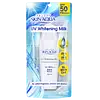What's inside
What's inside
 Key Ingredients
Key Ingredients

 Benefits
Benefits

 Concerns
Concerns

 Ingredients Side-by-side
Ingredients Side-by-side

Water
Skin ConditioningButylene Glycol
HumectantGlycerin
HumectantEthylhexyl Methoxycinnamate
UV AbsorberOctocrylene
UV AbsorberEthylhexyl Salicylate
UV AbsorberSalicylic Acid
MaskingCyclopentasiloxane
EmollientSuccinic Acid
Buffering1,2-Hexanediol
Skin ConditioningHydroxyacetophenone
AntioxidantCetearyl Alcohol
EmollientDiglycerin
HumectantCarbomer
Emulsion StabilisingPolysorbate 80
EmulsifyingPotassium Cetyl Phosphate
EmulsifyingTriethanolamine
BufferingPolyglyceryl-6 Distearate
EmulsifyingPropylene Glycol
HumectantSodium Polyglutamate
HumectantAllantoin
Skin ConditioningSorbitan Oleate
EmulsifyingSqualane
EmollientZinc Oxide
Cosmetic ColorantAdenosine
Skin ConditioningJojoba Esters
EmollientSodium Hyaluronate
HumectantCaprylic/Capric Triglyceride
MaskingGlucose
HumectantPolyglyceryl-3 Beeswax
EmulsifyingCetyl Alcohol
EmollientHydrogenated Lecithin
EmulsifyingHexylene Glycol
EmulsifyingStearic Acid
CleansingCholesterol
EmollientCeramide NP
Skin ConditioningCentella Asiatica Extract
CleansingCamellia Sinensis Extract
AntioxidantPolygonum Cuspidatum Root Extract
AntioxidantGlycyrrhiza Glabra Root Extract
BleachingChamomilla Recutita Flower Extract
MaskingRosmarinus Officinalis Leaf Extract
AntimicrobialPotassium Sorbate
PreservativeSodium Benzoate
MaskingPolysorbate 20
EmulsifyingSaccharomyces/Xylinum/Black Tea Ferment
Skin ConditioningEthylhexylglycerin
Skin ConditioningPalmitoyl Tripeptide-1
Skin ConditioningWater, Butylene Glycol, Glycerin, Ethylhexyl Methoxycinnamate, Octocrylene, Ethylhexyl Salicylate, Salicylic Acid, Cyclopentasiloxane, Succinic Acid, 1,2-Hexanediol, Hydroxyacetophenone, Cetearyl Alcohol, Diglycerin, Carbomer, Polysorbate 80, Potassium Cetyl Phosphate, Triethanolamine, Polyglyceryl-6 Distearate, Propylene Glycol, Sodium Polyglutamate, Allantoin, Sorbitan Oleate, Squalane, Zinc Oxide, Adenosine, Jojoba Esters, Sodium Hyaluronate, Caprylic/Capric Triglyceride, Glucose, Polyglyceryl-3 Beeswax, Cetyl Alcohol, Hydrogenated Lecithin, Hexylene Glycol, Stearic Acid, Cholesterol, Ceramide NP, Centella Asiatica Extract, Camellia Sinensis Extract, Polygonum Cuspidatum Root Extract, Glycyrrhiza Glabra Root Extract, Chamomilla Recutita Flower Extract, Rosmarinus Officinalis Leaf Extract, Potassium Sorbate, Sodium Benzoate, Polysorbate 20, Saccharomyces/Xylinum/Black Tea Ferment, Ethylhexylglycerin, Palmitoyl Tripeptide-1
Water
Skin ConditioningEthylhexyl Methoxycinnamate
UV AbsorberButylene Glycol
HumectantMethylene Bis-Benzotriazolyl Tetramethylbutylphenol
UV FilterPolymethylsilsesquioxane
Cyclopentasiloxane
EmollientTranexamic Acid
AstringentDiethylamino Hydroxybenzoyl Hexyl Benzoate
UV FilterPolysorbate 60
EmulsifyingCetearyl Alcohol
EmollientSilica
AbrasiveBis-Ethylhexyloxyphenol Methoxyphenyl Triazine
Skin ConditioningDecyl Glucoside
CleansingTitanium Dioxide
Cosmetic ColorantPhenoxyethanol
PreservativeTriethanolamine
BufferingAcrylates/C10-30 Alkyl Acrylate Crosspolymer
Emulsion StabilisingHexylglycerin
HumectantDisodium EDTA
Propylene Glycol
HumectantXanthan Gum
EmulsifyingSodium Acetylated Hyaluronate
HumectantWater, Ethylhexyl Methoxycinnamate, Butylene Glycol, Methylene Bis-Benzotriazolyl Tetramethylbutylphenol, Polymethylsilsesquioxane, Cyclopentasiloxane, Tranexamic Acid, Diethylamino Hydroxybenzoyl Hexyl Benzoate, Polysorbate 60, Cetearyl Alcohol, Silica, Bis-Ethylhexyloxyphenol Methoxyphenyl Triazine, Decyl Glucoside, Titanium Dioxide, Phenoxyethanol, Triethanolamine, Acrylates/C10-30 Alkyl Acrylate Crosspolymer, Hexylglycerin, Disodium EDTA, Propylene Glycol, Xanthan Gum, Sodium Acetylated Hyaluronate
 Reviews
Reviews

Ingredients Explained
These ingredients are found in both products.
Ingredients higher up in an ingredient list are typically present in a larger amount.
Butylene Glycol (or BG) is used within cosmetic products for a few different reasons:
Overall, Butylene Glycol is a safe and well-rounded ingredient that works well with other ingredients.
Though this ingredient works well with most skin types, some people with sensitive skin may experience a reaction such as allergic rashes, closed comedones, or itchiness.
Learn more about Butylene GlycolCetearyl alcohol is a mixture of two fatty alcohols: cetyl alcohol and stearyl alcohol. It is mainly used as an emulsifier. Emulsifiers help prevent the separation of oils and products. Due to its composition, it can also be used to thicken a product or help create foam.
Cetearyl alcohol is an emollient. Emollients help soothe and hydrate the skin by trapping moisture.
Studies show Cetearyl alcohol is non-toxic and non-irritating. The FDA allows products labeled "alcohol-free" to have fatty alcohols.
This ingredient is usually derived from plant oils such as palm, vegetable, or coconut oils. There is debate on whether this ingredient will cause acne.
Due to the fatty acid base, this ingredient may not be Malassezia folliculitis safe.
Learn more about Cetearyl AlcoholCyclopentasiloxane, or D5, is a silicone used to improve texture of products and trap moisture.
D5 is considered lightweight and volatile. Volatile means it evaporates quickly after application. Once evaporated, D5 leaves a thin barrier that helps keep skin hydrated.
It is also an emollient. Emollients help soften the skin and prevent water loss. Silicones create a silky texture in products. D5 helps other ingredients become more spreadable.
Studies show D5 is safe to use in skincare products. We recommend speaking with a skincare professional if you have concerns.
Learn more about CyclopentasiloxaneEthylhexyl Methoxycinnamate is an organic compound that provides UVB protection. It often goes by the more common name of octinoxate. It is created from methoxycinnamic acid and 2-ethylhexanol.
Ethylhexyl Methoxycinnamate absorbs UVB rays with wavelengths between 280-320 nm. UV absorbers protect your skin by using chemical reactions to convert UV rays into heat and energy.
UVB (290-320 nm) rays emit more energy than UVA rays. They are capable of damaging DNA, causing sunburns and are thought to be linked to skin cancer.
The state of Hawaii has banned sunscreens containing octinoxate due to its potential impact on coral reefs. More research is needed to bridge gaps in this research. The European Union allows higher levels of octinoxate in sunscreens than the US and Australia.
Ethylhexyl Methoxycinnamate is oil soluble. It is not stable and may lose efficacy when exposed to sunlight.
Learn more about Ethylhexyl MethoxycinnamatePropylene Glycol is an odorless, colorless liquid. As a humectant, it helps skin retain moisture. It also aids in delivering active ingredients.
Another role of this ingredient is preventing a product from melting or freezing. Propylene glycol also adds antimicrobrial properties to a product, elongating product lifespan.
This ingredient is considered an organic alcohol and commonly added into both cosmetics and foods.
Those with sensitive skin or conditions may develop a rash when using this ingredient.
Learn more about Propylene GlycolTriethanolamine is an emulsifier and pH adjuster. It is created using ethylene oxide and ammonia. This gives Triethanolamine a nitrogen core and a similar scent to ammonia.
As an emulsifier, it prevents ingredients from separating and enhances texture by adding volume to a product.
PH adjusters are common in cosmetic products. The pH of a product can affect the effectiveness of other ingredients. A product with a high pH may also irritate the skin.
Learn more about TriethanolamineWater. It's the most common cosmetic ingredient of all. You'll usually see it at the top of ingredient lists, meaning that it makes up the largest part of the product.
So why is it so popular? Water most often acts as a solvent - this means that it helps dissolve other ingredients into the formulation.
You'll also recognize water as that liquid we all need to stay alive. If you see this, drink a glass of water. Stay hydrated!
Learn more about Water